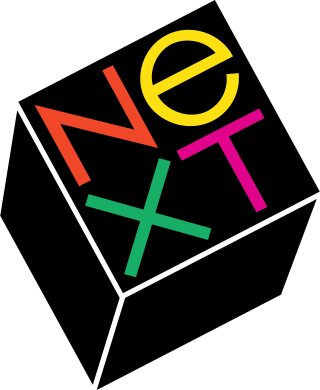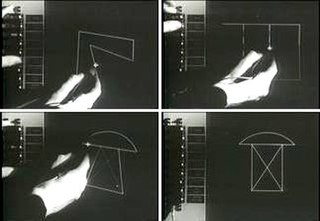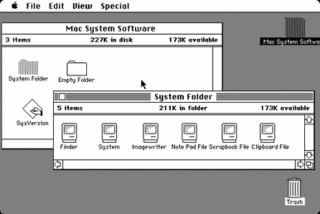| Private | |
| Website | www.solidthinking.com |
solidThinking is a software company developing Evolve, a 3D modeling and rendering software and Inspire, a concept generation tool.
| Private | |
| Website | www.solidthinking.com |
solidThinking is a software company developing Evolve, a 3D modeling and rendering software and Inspire, a concept generation tool.
Brothers Alex Mazzardo and Mario Mazzardo started the solidThinking project in 1991 with Guido Quaroni, today Vice President of Software R&D at Pixar Animation Studios. The design software was originally developed for NEXTSTEP, the operating system developed by NeXT, and it was soon awarded as the best new application in the "CAD and 3D" category at NeXTWORLD EXPO held in San Francisco in June 1993.

NeXT, Inc. was an American computer and software company founded in 1985 by Apple Computer co-founder Steve Jobs. Its name was usually pronounced as "Next". Based in Redwood City, California, the company developed and manufactured a series of computer workstations intended for the higher education and business markets. NeXT was founded by Jobs after he was fired from Apple, along with several co-workers. NeXT introduced the first NeXT Computer in 1988, and the smaller NeXTstation in 1990. The NeXT computers experienced relatively limited sales, with estimates of about 50,000 units shipped in total. Nevertheless, their innovative object-oriented NeXTSTEP operating system and development environment were highly influential.
A complete re-write of the application for the Windows platform was completed in 1998 with the release of solidThinking 3.0 for Windows. The Construction History and an extensive NURBS modeling toolset were the main additions. One year later solidThinking for Mac OS X was also released. Today all releases of solidThinking are simultaneously developed for both Windows and Mac OS X. [1]
Microsoft Windows is a group of several graphical operating system families, all of which are developed, marketed, and sold by Microsoft. Each family caters to a certain sector of the computing industry. Active Windows families include Windows NT and Windows Embedded; these may encompass subfamilies, e.g. Windows Embedded Compact or Windows Server. Defunct Windows families include Windows 9x, Windows Mobile and Windows Phone.
solidThinking version 8.0 and solidThinking Inspired 8.0, introducing the morphogenesis [2] form-generation technology, were released in September 2009.
With the 9.0 release, solidThinking became Evolve and solidThinking Inspired became Inspire, both sold under the solidThinking brand.
AutoCAD is a commercial computer-aided design (CAD) and drafting software application. Developed and marketed by Autodesk, AutoCAD was first released in December 1982 as a desktop app running on microcomputers with internal graphics controllers. Before AutoCAD was introduced, most commercial CAD programs ran on mainframe computers or minicomputers, with each CAD operator (user) working at a separate graphics terminal. Since 2010, AutoCAD was released as a mobile- and web app as well, marketed as AutoCAD 360.

The history of the graphical user interface, understood as the use of graphic icons and a pointing device to control a computer, covers a five-decade span of incremental refinements, built on some constant core principles. Several vendors have created their own windowing systems based on independent code, but with basic elements in common that define the WIMP "window, icon, menu and pointing device" paradigm.

macOS is a series of graphical operating systems developed and marketed by Apple Inc. since 2001. It is the primary operating system for Apple's Mac family of computers. Within the market of desktop, laptop and home computers, and by web usage, it is the second most widely used desktop OS, after Microsoft Windows.

An operating system (OS) is system software that manages computer hardware and software resources and provides common services for computer programs.

PowerPC is a reduced instruction set computing (RISC) instruction set architecture (ISA) created by the 1991 Apple–IBM–Motorola alliance, known as AIM. PowerPC, as an evolving instruction set, has since 2006 been named Power ISA, while the old name lives on as a trademark for some implementations of Power Architecture-based processors.

NeXTSTEP is a discontinued object-oriented, multitasking operating system based on UNIX. It was developed by NeXT Computer in the late 1980s and early 1990s and was initially used for its range of proprietary workstation computers such as the NeXTcube. It was later ported to several other computer architectures.
Darwin is an open-source Unix-like operating system first released by Apple Inc. in 2000. It is composed of code developed by Apple, as well as code derived from NeXTSTEP, BSD, Mach, and other free software projects.
OpenStep is a defunct object-oriented application programming interface (API) specification for a legacy object-oriented operating system, with the basic goal of offering a NeXTSTEP-like environment on non-NeXTSTEP operating systems. OpenStep was principally developed by NeXT with Sun Microsystems, to allow advanced application development on Sun's operating systems, specifically Solaris. NeXT produced a version of OpenStep for its own Mach-based Unix, stylized as OPENSTEP, as well as a version for Windows NT. The software libraries that shipped with OPENSTEP are a superset of the original OpenStep specification, including many features from the original NeXTSTEP.
Cocoa is Apple's native object-oriented application programming interface (API) for its desktop operating system macOS.
In computing, cross-platform software is computer software that is implemented on multiple computing platforms. Cross-platform software may be divided into two types; one requires individual building or compilation for each platform that it supports, and the other one can be directly run on any platform without special preparation, e.g., software written in an interpreted language or pre-compiled portable bytecode for which the interpreters or run-time packages are common or standard components of all platforms.
In computer architecture, 64-bit computing is the use of processors that have datapath widths, integer size, and memory address widths of 64 bits. Also, 64-bit computer architectures for central processing units (CPUs) and arithmetic logic units (ALUs) are those that are based on processor registers, address buses, or data buses of that size. From the software perspective, 64-bit computing means the use of code with 64-bit virtual memory addresses. However, not all 64-bit instruction sets support full 64-bit virtual memory addresses; x86-64 and ARMv8, for example, support only 48 bits of virtual address, with the remaining 16 bits of the virtual address required to be all 0's or all 1's, and several 64-bit instruction sets support fewer than 64 bits of physical memory address.

Mac OS 8 is an operating system that was released by Apple Computer, Inc. on July 26, 1997. It represents the largest overhaul of the classic Mac OS since the release of System 7, approximately six years before. It emphasizes color more than prior versions. Released over a series of updates, Mac OS 8 represents an incremental integration of many of the technologies which had been developed from 1988 to 1996 for Apple's overly-ambitious OS named Copland. Mac OS 8 helped modernize the Mac OS while Apple developed its next generation operating system, Mac OS X.
Generative music is a term popularized by Brian Eno to describe music that is ever-different and changing, and that is created by a system.
Apple's Intel transition was the process of changing the central processing unit (CPU) of Macintosh computers from PowerPC processors to Intel x86 processors. The transition became public knowledge at the 2005 Worldwide Developers Conference (WWDC), when Apple's CEO Steve Jobs made the announcement that the company would make a transition from the use of PowerPC microprocessors supplied by Freescale and IBM in its Macintosh computers, to processors designed and manufactured by Intel, a chief supplier for most of Apple's competitors.

The architecture of macOS describes the layers of the operating system that is the culmination of Apple Inc.'s decade-long search and development process to replace the classic Mac OS.

The Macintosh is a family of personal computers designed, manufactured, and sold by Apple Inc. since January 1984. The original Macintosh was the first mass-market personal computer that featured a graphical user interface, built-in screen and mouse. Apple sold the Macintosh alongside its popular Apple II family of computers for almost ten years before they were discontinued in 1993.

The family of Macintosh operating systems developed by Apple Inc. includes the graphical user interface-based operating systems it has designed for use with its Macintosh series of personal computers since 1984, as well as the related system software it once created for compatible third-party systems.
The following outline is provided as an overview of and topical guide to Apple Inc.:

Andrew "Andy" C. Stone is an American computer programmer best known for his iOS app Twittelator, which to date has sold over a million units for the iPhone and the iPad. The founder, director, and principal programmer for Stone Design Corporation, Albuquerque, New Mexico. In his 25 plus year career as a programmer, he has published over 35 software titles for Hypercard, the NeXT workstation, Mac OS X, and currently for iOS iPhones and iPads.